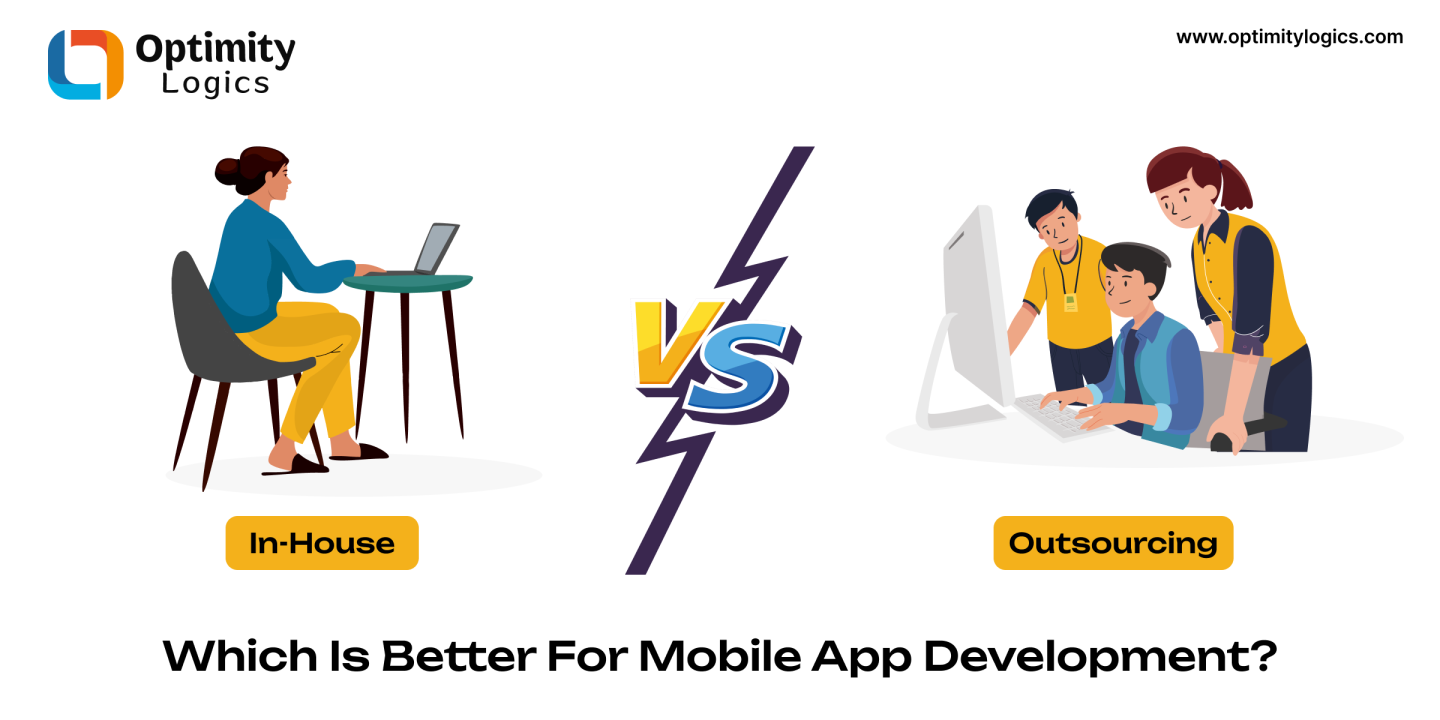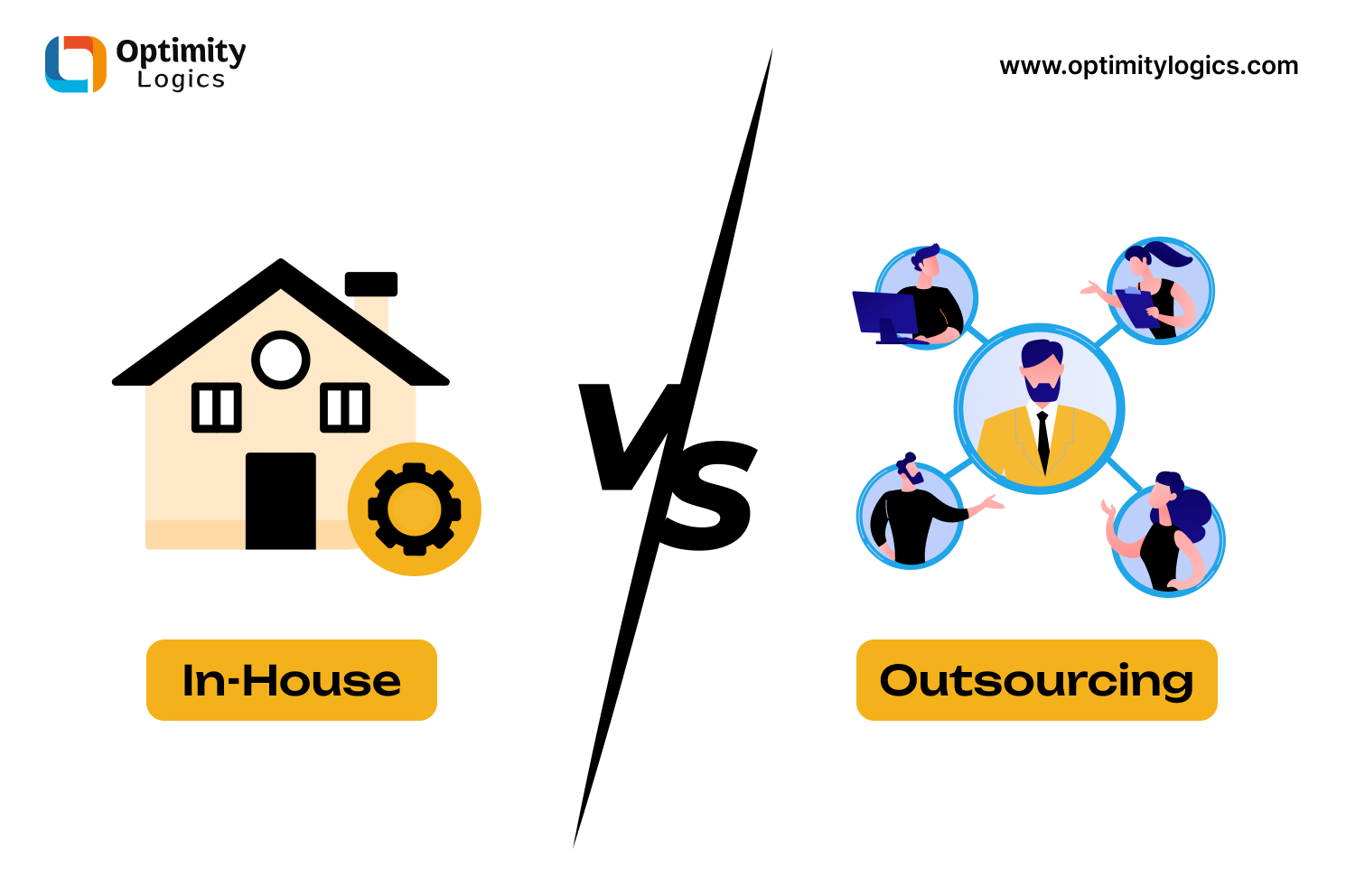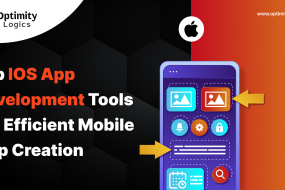
In-House or Outsourcing: Which is Better for Mobile App Development? Mobile applications have become an essential tool for businesses, helping them expand their reach, boost customer engagement, and streamline operations. However, one critical decision companies face is whether to develop an app in-house or outsource the project to an external development team.
According to a Deloitte 2024 survey, over 70% of companies outsource software development to reduce costs and focus on core business functions. However, many organisations still prefer in-house development for greater control, security, and seamless integration with their existing teams.
At Optimity Logics, we specialise in helping businesses navigate this decision. In this blog, We will explore both development approaches, their benefits, challenges, and key factors to consider when choosing the right strategy for your mobile app development.
Understanding In-House Mobile App Development

In-house development involves building a mobile application using an internal team of designers, developers, and project managers? So, this approach gives businesses full control over the development process, from conceptualization to deployment and ongoing maintenance.
Advantages of In-House Development
✔ Full Control Over the Project
Firstly, at Optimity Logics, we understand that businesses often want complete control over their development projects. Also, an in-house team ensures that the app aligns perfectly with the company’s vision, branding, and long-term objectives.
✔ Enhanced Security & Compliance
Secondly, keeping development in-house minimizes the risk of data leaks and security breaches, which is crucial for businesses handling sensitive customer or financial information. Industries like fintech, healthcare, and government services often opt for in-house development due to strict data protection regulations.
✔ Stronger Collaboration & Communication
Moreover, with an internal team, real-time collaboration becomes easier. As well as, Developers, designers, and business stakeholders can quickly exchange feedback, reducing misunderstandings and ensuring faster decision-making.
✔ Ongoing Maintenance & Updates
Lastly, After launch, an in-house team ensures that the app remains optimized and updated. Also, companies can continuously improve performance, fix bugs, and add new features without relying on an external provider.
Challenges of In-House Development
✖ Higher Operational Costs
Firstly, maintaining an in-house team requires a significant investment in salaries, software licenses, training, and infrastructure. So, for startups or businesses on a tight budget, these costs can be a major drawback.
✖ Talent Acquisition & Retention
Finding and retaining skilled mobile developers can be challenging, especially in competitive markets. Moreover, based on the Statista 2024 report, demand for app developers has increased by 30% in the past three years, making hiring top talent more expensive.
✖ Longer Development Timelines
Recruiting, onboarding, and training an internal team can delay the app development process, leading to a longer time-to-market compared to outsourcing.
Understanding Outsourcing Mobile App Development

Outsourcing involves hiring an external agency, freelancers, or offshore developers to handle the mobile app development process. So, many businesses choose this route to gain cost efficiency, access to expert talent, and faster project execution.
Advantages of Outsourcing Development
✔ Cost-Efficiency Without Compromising Quality
Companies partnering with Optimity Logics can significantly reduce development costs while maintaining high-quality output. Also, Outsourcing to regions with lower labor costs enables businesses to allocate budgets more effectively without sacrificing app performance.
✔ Access to Specialized Expertise
Outsourcing allows businesses to tap into a global talent pool of experienced developers, designers, and testers. This is particularly useful when developing complex apps that require niche skills in AI, blockchain, AR/VR, or IoT technologies.
✔ Faster Development & Deployment
External development agencies often work on strict deadlines, ensuring that the app is delivered on time and within budget. So, with Optimity Logics, we help businesses speed up their development cycle without compromising on quality.
✔ Scalability & Flexibility
With outsourcing, businesses can easily scale their development teams up or down based on project requirements. Moreover, this flexibility is essential for companies that experience fluctuating workloads.
Challenges of Outsourcing Development
✖ Reduced Control Over the Development Process
Since the project is handled externally, companies may have limited visibility into the daily development activities. However, at Optimity Logics, we ensure transparent communication and regular progress updates to keep businesses in control.
✖ Communication & Time Zone Differences
When working with offshore teams, language barriers or time zone differences can lead to occasional delays. So, choosing a reliable outsourcing partner that offers dedicated project managers can minimize these challenges.
✖ Data Security & Confidentiality Risks
Outsourcing requires strong legal agreements, such as NDAs (Non-Disclosure Agreements), to protect intellectual property and sensitive business data.
Latest Market Trends in Mobile App Development
- The global IT outsourcing market is projected to reach $1.3 trillion by 2027,
driven by businesses prioritizing cost savings and faster development cycles (Statista, 2024). - 94% of businesses reported increased efficiency and productivity after outsourcing IT services (Deloitte, 2024).
- The US mobile app market is expected to hit $935 billion by 2025, increasing
demand for both in-house and outsourced development (Grand View Research,
2024).
How to Decide: In-House v/s Outsourcing?

Choose In-House Development If:
– Your business requires full control over the app development process.
– Security and compliance are top priorities.
– A long term budget is available to maintain a dedicated team.
Choose Outsourcing If:
– You want to reduce costs without compromising quality.
– Your company lacks in-house expertise in mobile app development.
– Your need a faster development cycle to meet market demand.
A Balanced Approach: Hybrid Development
– Many companies are adopting a hybrid model, blending in-house development with outsourcing specialized tasks.
This method provides:
Security & Control: Keeping core development in-house.
Cost-Effective Execution: Outsourcing UI/UX design, testing, or maintenance.
Faster Go-To-Market: Accelerating development while ensuring quality.
At Optimity Logics, we offer customized hybrid solutions, allowing businesses to
maximize efficiency while maintaining project oversight.
Final Thoughts
Finally, the choice between in-house and outsourcing mobile app development depends on budget, project complexity, security needs, and development timelines.
✔ If control and data security are your top priorities, in-house development is the best option.
✔ If cost savings and faster deployment matter most, outsourcing is the smarter choice.
At Optimity Logics, we provide tailored mobile app development solutions, whether you choose an in-house, outsourcing, or a hybrid approach. Contact us today to discuss the best strategy for your business!












